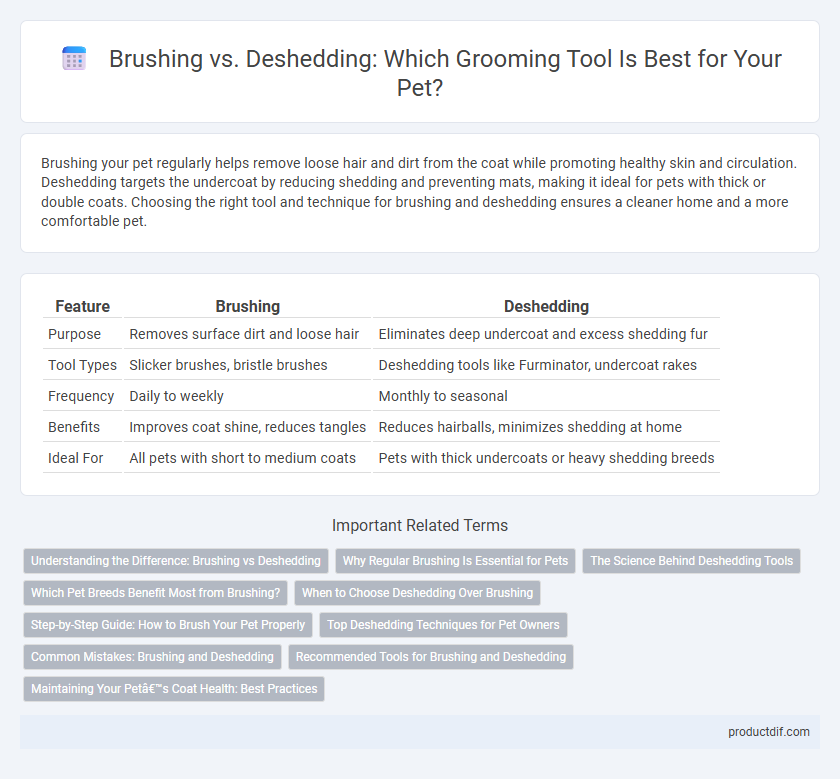Brushing your pet regularly helps remove loose hair and dirt from the coat while promoting healthy skin and circulation. Deshedding targets the undercoat by reducing shedding and preventing mats, making it ideal for pets with thick or double coats. Choosing the right tool and technique for brushing and deshedding ensures a cleaner home and a more comfortable pet.
Table of Comparison
| Feature | Brushing | Deshedding |
|---|---|---|
| Purpose | Removes surface dirt and loose hair | Eliminates deep undercoat and excess shedding fur |
| Tool Types | Slicker brushes, bristle brushes | Deshedding tools like Furminator, undercoat rakes |
| Frequency | Daily to weekly | Monthly to seasonal |
| Benefits | Improves coat shine, reduces tangles | Reduces hairballs, minimizes shedding at home |
| Ideal For | All pets with short to medium coats | Pets with thick undercoats or heavy shedding breeds |
Understanding the Difference: Brushing vs Deshedding
Brushing removes surface dirt and loose fur from your pet's coat, promoting healthy skin and a shiny appearance. Deshedding targets the undercoat by reaching deeper layers to reduce shedding significantly and prevent hairballs in cats or matting in dogs. Selecting the proper tool for brushing or deshedding helps maintain your pet's coat health and minimizes stray hair in your home.
Why Regular Brushing Is Essential for Pets
Regular brushing removes loose fur, reduces shedding, and prevents matting, which maintains a pet's skin health and coat shine. It stimulates natural oil production, promoting a healthier and more vibrant coat while helping to detect parasites or skin issues early. Consistent brushing strengthens the bond between pet and owner, contributing to overall well-being and comfort.
The Science Behind Deshedding Tools
Deshedding tools work by targeting the undercoat layer of a pet's fur, where loose and dead hair accumulates, which regular brushing often misses. These tools use specially designed blades or teeth to gently lift and remove the undercoat without damaging the topcoat, reducing shedding and matting effectively. Research shows that regular use of deshedding tools can minimize allergens and maintain a healthier skin barrier by preventing hair follicle clogging.
Which Pet Breeds Benefit Most from Brushing?
Long-haired breeds like Persian cats and Afghan Hounds benefit most from brushing, which helps prevent matting and distribute natural oils for healthy coats. Brushing also suits medium-haired breeds such as Golden Retrievers, enhancing coat shine and reducing loose fur. Short-haired breeds may require less frequent brushing but still benefit from regular sessions to remove dead hair and maintain skin health.
When to Choose Deshedding Over Brushing
Deshedding tools are essential during heavy shedding seasons to effectively remove loose undercoat fur that regular brushing cannot reach. Choose deshedding when your pet's shedding causes excessive hair around the home or when grooming time is limited but deep fur removal is needed. Deshedding also helps prevent matting and reduces allergens by targeting the dense, shedding layer beneath the topcoat.
Step-by-Step Guide: How to Brush Your Pet Properly
Start by selecting the right brush type based on your pet's coat, such as a slicker brush for long hair or a bristle brush for short hair. Begin brushing gently at your pet's head and move toward the tail, using slow, firm strokes to remove dirt and loose hair without irritating the skin. Pay special attention to mats and tangles, using a dematting tool if necessary, and finish by brushing in the direction of hair growth to promote a healthy, shiny coat.
Top Deshedding Techniques for Pet Owners
Effective deshedding techniques for pet owners include using specialized tools like the Furminator or deshedding brushes designed to reach the undercoat without damaging the topcoat. Regular grooming sessions incorporating gentle brushing combined with targeted deshedding help reduce loose fur and minimize shedding around the home. Consistent deshedding supports healthier skin and coat, reducing hairballs in cats and matting in dogs.
Common Mistakes: Brushing and Deshedding
Common mistakes in brushing and deshedding pets include using the wrong type of tool, such as a bristle brush instead of a deshedding tool, leading to ineffective fur removal and potential skin irritation. Pet owners often brush too aggressively or with inconsistent frequency, causing discomfort or failing to prevent mats and shedding. Neglecting regular deshedding can result in excessive fur buildup and increases the risk of hairballs in cats and fur ingestion in dogs.
Recommended Tools for Brushing and Deshedding
Recommended tools for brushing pets include slicker brushes and bristle brushes, designed to remove loose hair and dirt while stimulating the skin. For deshedding, tools such as deshedding combs and undercoat rakes effectively target and remove the dense undercoat, reducing shedding significantly. Choosing the right tool depends on your pet's coat type, with brushing tools suited for surface grooming and deshedding tools optimized for deep fur removal.
Maintaining Your Pet’s Coat Health: Best Practices
Brushing your pet regularly removes loose fur and dirt, promoting healthy skin and a shiny coat, while deshedding targets the undercoat to reduce shedding significantly. Using the right tools, such as slicker brushes for brushing and deshedding tools like the Furminator, ensures effective grooming tailored to your pet's coat type. Consistent grooming routines prevent matting, minimize hairballs in cats, and maintain your pet's overall coat health and comfort.
Brushing vs Deshedding Infographic

 productdif.com
productdif.com